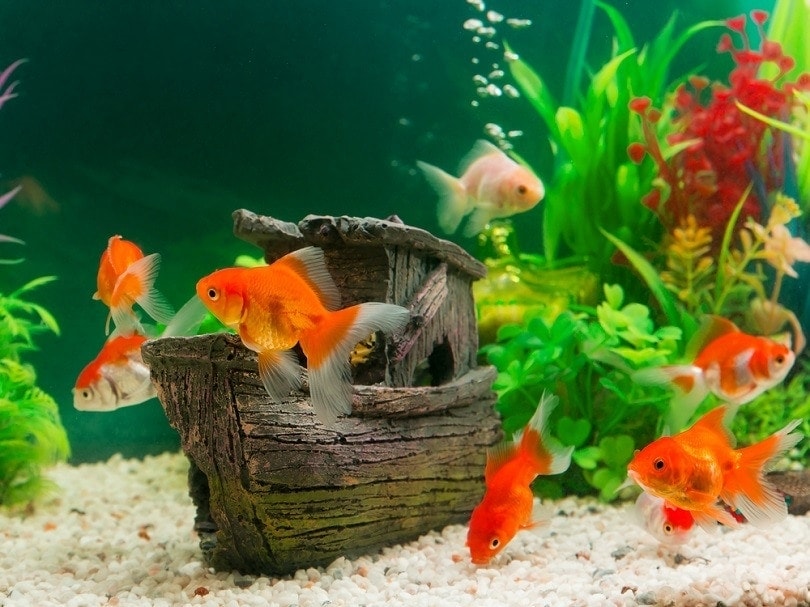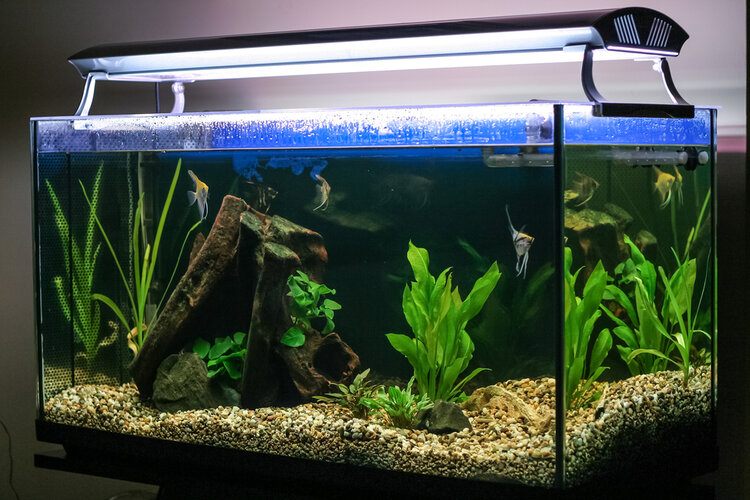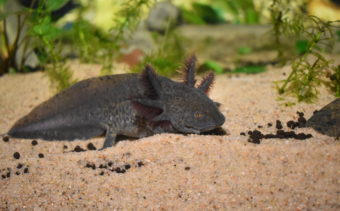Bala Shark: Fish Care Guide, Pictures, Types, Lifespan & More

Updated on
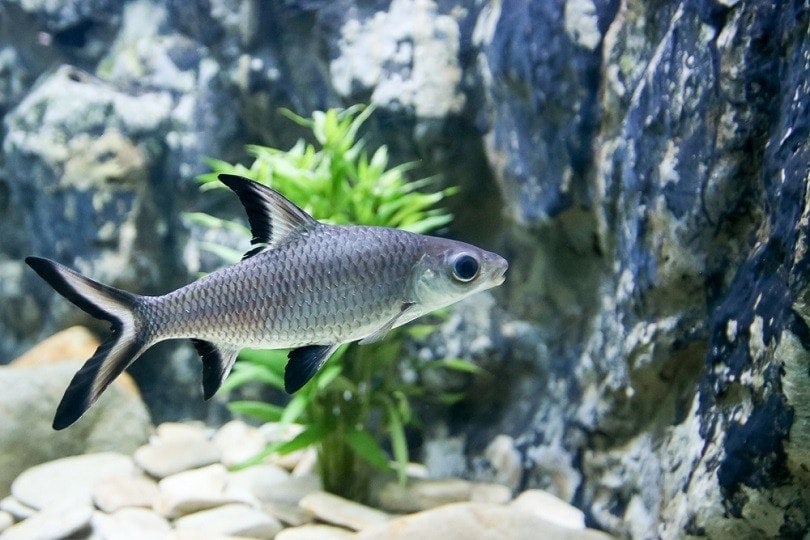
Bala sharks are probably the most popular type of tropical aquarium shark in the world. Their interesting nature entices aquarists to enter the world of Bala sharks. Caring for these skittish silverfish is not for beginners and Bala sharks are particularly sensitive to water chemistry and temperature. They live a decent lifespan and can do well in smaller tropical aquariums, but are happiest in schools with no aggressive behavior towards each other, making a lovely centerpiece to aquariums.
Quick Facts About Bala Sharks
| Species Name: | Balantiocheilos melanopterus |
| Family: | Cyprinid |
| Care Level: | Intermediate to advanced |
| Temperature: | Tropical (24°C-28°C) |
| Temperament: | Shy, peaceful |
| Color Form: | Black, grey, and yellow |
| Lifespan: | 8 to 10 years |
| Size: | 12 inches |
| Diet: | Omnivore |
| Minimum Tank Size: | 20 gallons |
| Tank Set-Up: | Planted, sheltered |
| Compatibility: | Moderate |
Bala Shark Overview
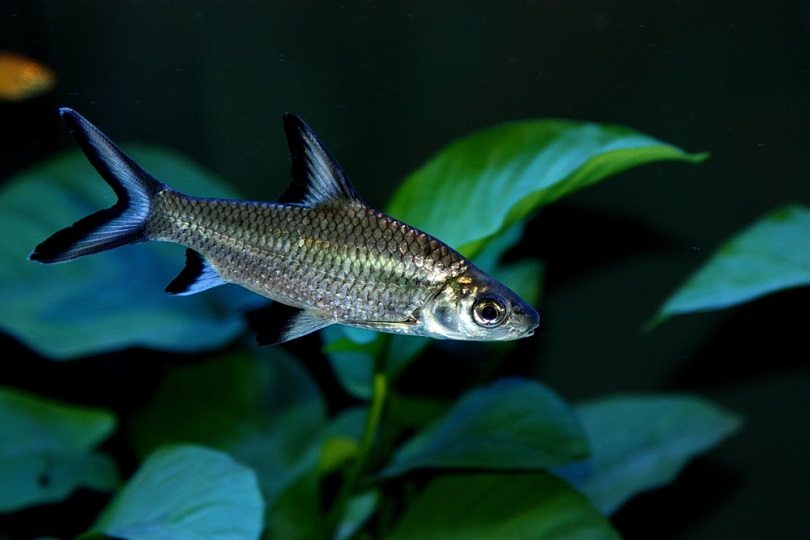
Bala sharks are interesting fish and are more attractive than other species of cyprinid. The Bala shark is a type of minnow, commonly called the tricolor shark, shark minnow, or silver shark. Besides the aquarium labeled name, Bala sharks are not a true species of shark.
The Bala shark is native to the warm waters of the Malay Peninsula, Sumatra, and Borneo, found naturally in midwater depths. Their primary habitat is tropical rivers and lakes where they are observed to school in large groups and hide between overgrown foliage. Unfortunately, Bala sharks are prone to developing illness. Common illnesses such as fungal or bacterial growths are typically observed when introducing a Bala shark into the aquarium. They are sensitive to a variety of water problems and become stressed easily. All Bala sharks should be quarantined for 2 weeks before placing them in the main tank. You may notice your Bala shark missing scales and developing clouded eyes. Treatments should be done immediately to preserve the rest of the fish in the tank.
Bala sharks are not recommended for sparsely decorated enclosures where they will feel threatened. Their natural homes are tannin-rich with a multitude of plants growing from the river or lake’s soil. Aquarium branches like driftwood are greatly appreciated by Bala sharks as enrichment and as an extra place to hide.
How Much Do Bala Sharks Cost?
Bala sharks are cheap and easy to acquire in the fish industry. Due to their high demand from consumers, Bala sharks are appropriately priced at large chain pet stores and healthier forms can be found at privately-owned family fish stores. The overall price of a Bala shark may vary depending on the size, health, and age you are receiving the shark at. Smaller Bala sharks sell at a minimum of $1, whereas larger and quality Bala sharks can sell for up to $6. It is important that you do a health check of your Bala shark before the purchase. Due to their sensitivity, it is a good idea to ask the store owner where the Bala sharks are imported from. Wild-caught Bala sharks do not do well in captivity.
Typical Behavior & Temperament
Bala sharks naturally school together in the wild. They do best when housed as a pair or more in an aquarium to ensure their stress is kept at a minimum. Since it is a natural behavior for these fish to school, their overall temperament is peaceful, and they get along with other peaceful varieties of large tropical fish.
Bala sharks are active fish that will display a flicking motion when they swim. They are quick to get from side to side within the tank and will dart behind a decoration when they feel disturbed. Bala sharks are always on the alert for potential predators and are the first to get to the food in the tank. Bala sharks add a great deal of liveliness to aquariums as they are active schooling groups providing entertainment for the owner.
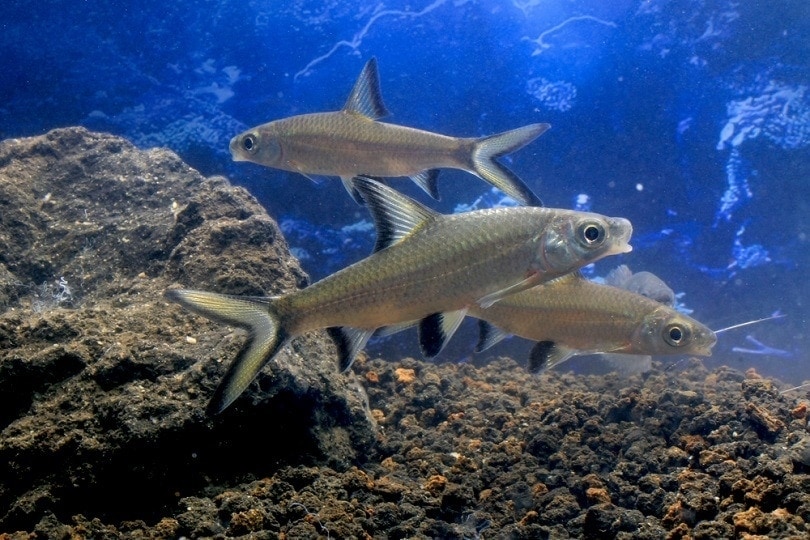
Appearance & Varieties
Bala sharks do not come in color varieties. They stick to a seemingly ordinary white, silver, and black pattern. Bala sharks’ bodies are a shimmering silver color, the fins are patterned with black, and a white color striped band is seen separating the patterns. Bala sharks have a relatively disproportionate eye-to-head ratio. They have round and black button eyes that instinctively flicker around. Although there are no separations between the iris in the eyeball, the iris is substantially lighter than the full eye.
The Bala shark has large triangular-shaped dorsal fins and a torpedo-shaped body. This is what gave this minnow its name. Although their appearance is shark-like, the resemblance ends there. The Bala shark has three tricolors, well-defined scales, and a deeply forked yellow-tinged tail. The pelvic, caudal, dorsal, and anal fins are edged in a deep black.
Bala sharks grow to an outstanding size unexpected for most new owners. The Bala shark can grow into its 12–13-inch adult size. As the Bala shark matures, the underside of the female Bala shark will become rounder and more prominent. She will lose her sleek body type and swim slower. This makes the female appear rounder than the males.
How to Take Care of Bala Shark
Habitat, Tank Conditions & Setup
Tank/aquarium size
The juvenile pet store size of 3–6-inch adults do well in a tank of 20 gallons per Bala shark. Adult varieties will need exceptionally large tanks, especially when in large groups. An outdoor DIY aquarium is a good option to ensure you provide the adult Bala shark with plenty of space. Keeping up to 3 juvenile Bala sharks in a 30-gallon is possible if you plan to upgrade as they grow and mature. A 120-gallon tank with a group of 6 Bala sharks is recommended.
Water temperature and pH
Bala sharks require a pH of 6.0 to 7.8, but they are not fussy when it comes to the acidity or alkalinity of the water. Bala sharks are tropical fish and appreciate heated aquariums. A stable temperature between 24° to 28° is ideal. The temperature should be 27.5°C when you are quarantining the Bala shark to ensure diseases and infections from colder temps do not risk the fish’s immune system.
Substrate
Bala sharks can be housed in tanks that are either bare-bottom or have sand, gravel, or pebbles as a substrate. Algae carpets are welcomed by the Bala shark who is not picky when it comes to what is layered on the bottom of the aquarium.
Plants
Bala sharks need a heavily planted tank to feel safe. They will use the leaves and stems as a safe place to hide. Due to Bala sharks being on the shy side, you may find they suffer in sparse tanks. Fake plants do the trick, but a large amount is needed to create a naturally safe feel
Lighting
Strongly lit or the usage of artificial lights in a Bala shark tank is to be avoided. Bala sharks have sensitive eyes that see better in tannin-rich waters. Excess lights may cause your Bala shark unnecessary stress and cause them to hide frequently.
Filtration
Bala sharks need a quality filter that can filter five times the water volume in the tank. Providing live plants in the tank helps keep the water cleaner. Bala sharks are sensitive to spikes in ammonia, nitrite, and nitrates.
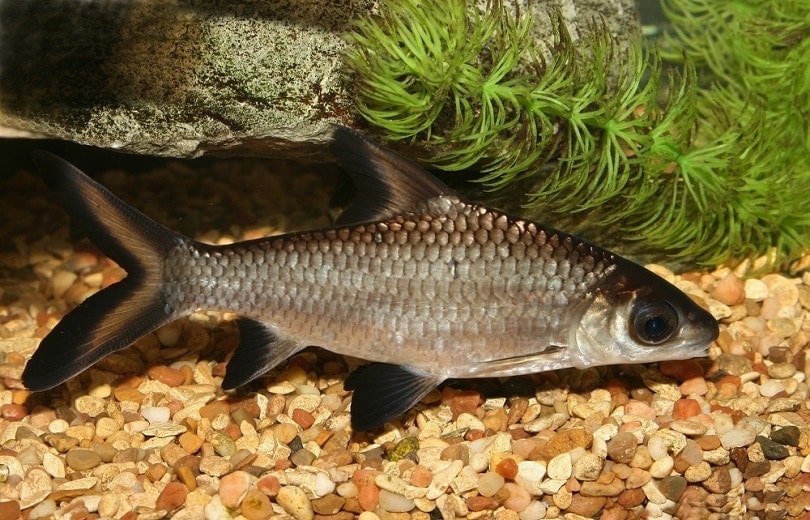
Are Bala Sharks Good Tank Mates?
Bala sharks are social yet wary fish who appreciate other peaceful fish sharing the tank. Since Bala sharks school, they should ideally be with their same species. It is important to keep in mind the adult size your Bala shark is going to reach. When purchasing more than one Bala shark, ensure you plan to upgrade them to a large tank or provide one from the start. Bala sharks are susceptible to fin nipping and can swallow any fish that can fit in their mouth. They will chase potential tempered fish and can in turn be chased by other fish.
Although they can live with a non-territorial blood parrot cichlid, it is important to avoid other types of aggressive cichlids. Always ensure you keep a close eye on tankmates and how they interact. No fish should be hiding, chasing, or competing with the others. Bala sharks should not be housed with cold water fish who have completely different tank condition requirements. This can be avoided when keeping Bala sharks in large groups, but it is essential to ensure the tank mates are on our suitability list.
- Iridescent sharks
- Angelfish
- Rainbowfish
- Clown Loach
- Discus fish
- Gourami
- Blood parrot Cichlid
- Tinfoil Barbs
- Ghost knife fish
- Siamese fighting fish
- Oscars
- Livebearers
- Danios
- Tetras
- Guppies
What to Feed Your Bala Shark
Bala sharks are primarily omnivores. They require both plant and animal-based materials in their diet. Luckily, pet stores sell a variety of pre-made foods suitable for your Bala shark. Foods such as flakes, granules, pellets, and gel foods are suitable. Each food should be specifically formulated for omnivorous tropical fish foods. It is good to feed different types of foods on different days, this ensures that your Bala shark is receiving good variety within its diet.
Bala sharks are prone to malnutrition and their diet should be calculated appropriately. They can be fed tubifex or bloodworms alongside their staple diet. A rotating feeding schedule can be used so you do not have to worry about your Bala shark missing out on any essential nutrients. It is best to avoid feeding your Bala shark cheap branded foods with lots of fillers. Feeding the wrong foods long-term will result in deformities, stunting, and bloat. Fresh foods such as grated carrots and cucumber can be fed as an additional snack. Water-based foods like cucumber or green garden peas help to relieve bloating.
Keeping Your Bala Shark Healthy
If you meet your Bala sharks tank, diet, and tank mate requirements, you will be rewarded with a healthy Bala shark inside and out. To keep your Bala shark in excellent health, you want to ensure you use a heater in the aquarium. A preset heater is the best option, and it will turn on and off when necessary. If the room temperature is warm, the heater may seldomly turn on as the water is above the preset temperature. If you keep a school of Bala sharks, you will greatly reduce stress amongst them. In return, this leads to healthier fish who feel safe among others.
Feed a mixed variety of foods and supplement with healthy snacks two to three times a week. Starting a planted tank aids in natural vibrancy and safety in the tank. Keep your Bala shark in the largest tank possible. Doing weekly water tests via a liquid testing kit helps you to monitor the water’s conditions and determine when it is time for a water change. Do not overfeed the sharks, as the ammonia will spike and become unstable.
Breeding
Bala sharks can mate with each other when they are still young. This enables them to keep their schooling groups large in the wild. The Bala shark reaches sexual maturity at the size of 4 inches. When compared to its maximum adult size of 12 inches, they mate when they are 6 to a year old. Successfully breeding healthy Bala sharks is moderately complicated in captivity. All the necessary breeding requirements need to be met for them to produce healthy fry.
When Bala sharks are young, it may be hard to determine gender. Males are slightly longer and larger than females who are rounded and appear oval when they reach a certain size. If you keep a large school of Bala sharks, there is a high chance you have both a male and a female. The female will lay sticky eggs against plants to which the chosen mate will spray milt over. Bala sharks need warm temperatures to encourage breeding. Slowly warm up the tank to replicate the natural breeding changes that occur in the wild.
Are Bala Sharks Suitable For Your Aquarium?
If you have a large tank ideally over 100 gallons, with planted and tannin-rich water, the Bala shark will fit right in! The tank should be in the range of tropical conditions and house other peaceful tank mates that do not cause trouble with Bala sharks. Ideally, you should plan to house more than one Bala shark to encourage schooling. If your tank is small and you do not have plans to upgrade, a Bala shark will not be suitable for your aquariums due to its rapid growth. The temperature in your aquarium should not fluctuate or be exposed to periods of coldness. It is not recommended to keep Bala sharks in overcrowded conditions, this will cause stress amongst the fish and a weakened immune system. Ensure the tank has adequate aeration and filtration. We hope this article has informed you of proper Bala shark care.
Check out some of our other tank life species care guides:
- Rainbow Shark: Care Guide, Varieties, Lifespan & More (with Pictures)
- Freshwater Eels: Care Guide, Pictures, Varieties, Lifespan & More
- Ember Tetra: Care Guide, Varieties, Lifespan & Traits (with Pictures)
Featured Image Credit: PingPasslens, Shutterstock





